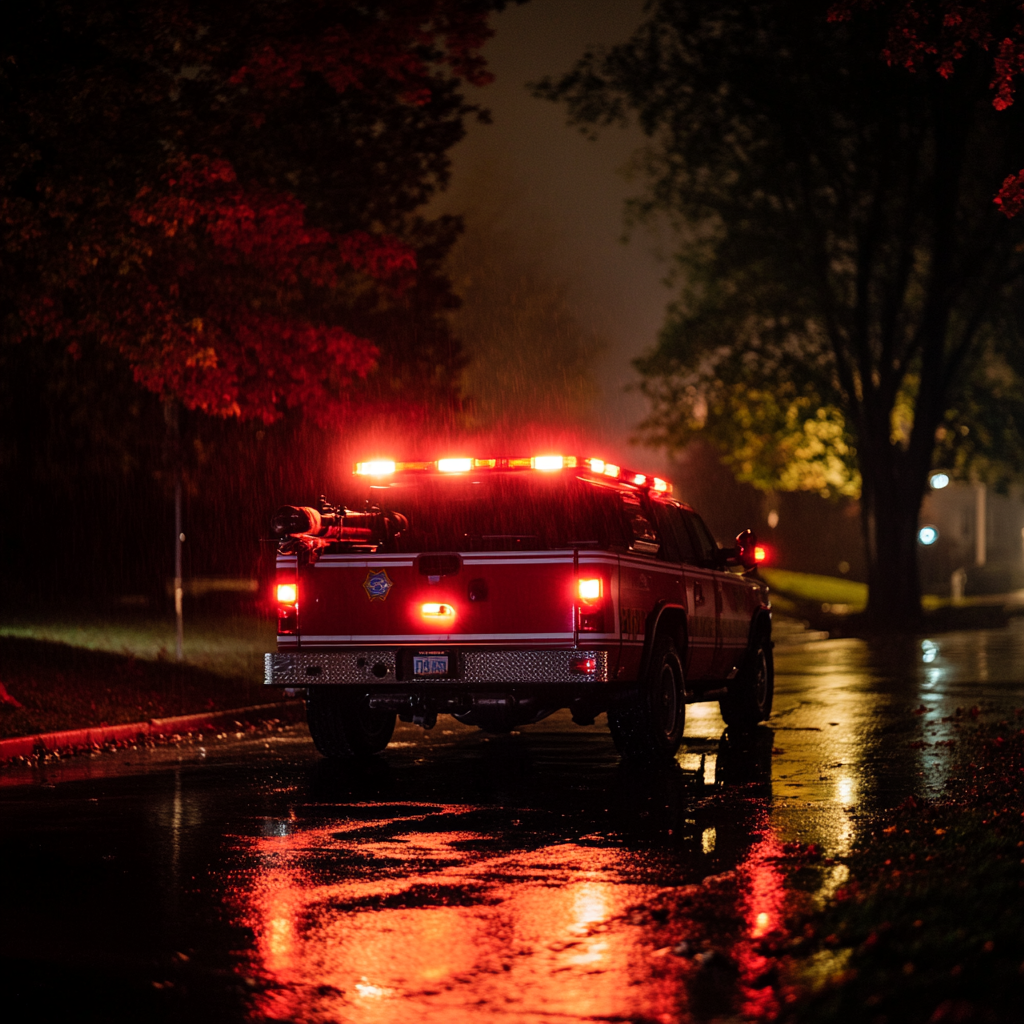When you drive down the road, you've likely noticed vehicles with distinctive flashing lights. From the urgent blues and reds of emergency vehicles to the cautionary ambers of work trucks, car flashing lights serve various crucial purposes. But what about adding flashing lights to your personal vehicle?
Whether you're a volunteer firefighter needing to equip your car for emergency response or simply curious about enhancing your vehicle's visibility, this comprehensive guide will illuminate the world of car flashing lights.
Understanding Car Flashing Lights: Types and Uses
Car flashing lights come in a variety of types, colors, and configurations. Let's break down the most common categories:
Emergency Vehicle Lights
- Police cars: Usually blue and red
- Fire trucks: Primarily red, sometimes with white
- Ambulances: Red and white, sometimes with blue
Warning Lights
- Construction vehicles: Typically amber
- Tow trucks: Usually amber
- Utility vehicles: Often amber or yellow
Volunteer Emergency Responder Lights
- Colors vary by state, often amber or green
- Used by volunteer firefighters, EMTs, and search and rescue personnel
Decorative Lights
- Underglow lights
- Interior accent lighting
Understanding these categories is crucial when considering adding flashing lights to your car, as each type has specific legal and practical implications.
Can You Put Flashing Lights on Your Car?
The short answer is yes, but with significant caveats. The legality and appropriateness of adding flashing lights to your car depend on several factors:
- Purpose: Why are you adding the lights? Emergency response, work-related visibility, or personal aesthetics?
- Color: Different colors have different legal restrictions.
- Location: Where on the vehicle will the lights be mounted?
- Usage: When and how will you activate the lights?
Legal Considerations for Flashing Lights on a Car
Laws regarding car flashing lights vary significantly by location. Here are some general guidelines:
- Emergency Colors: Red and blue lights are typically restricted to official emergency vehicles in most jurisdictions.
- Amber Lights: Often legal for civilian use, especially for work-related purposes.
- Volunteer Responder Lights: Many states have specific regulations for volunteer firefighters and EMTs using personal vehicles.
- Decorative Lights: Usually legal when the vehicle is stationary, but often prohibited while driving.
Always check your local and state laws before installing any flashing lights on your car.
Flashing Lights for Volunteer Firefighters' Personal Vehicles
For volunteer firefighters, adding appropriate flashing lights to a personal vehicle is often necessary for effective emergency response. Here's what you need to know:
- Color Restrictions: Many states allow volunteer firefighters to use red lights, but some restrict usage to amber or green.
- Permit Requirements: Most jurisdictions require official authorization or permits for volunteer responders to use emergency lights.
- Usage Limitations: Typically, these lights can only be used when responding to an emergency call.
- Training: Many departments require training on the proper use of emergency lights on personal vehicles.
Recommended Light Types for Volunteer Firefighters
- Dash Lights: Easily installed and removed, ideal for maintaining vehicle discretion when off-duty.
- Grille Lights: Provide powerful forward lighting without permanent modification.
- Magnetic Roof Lights: Offer high visibility and easy removal.

How to Legally Install Flashing Lights on Your Car
Whether for emergency response or work-related purposes, here's how to properly install car flashing lights:
- Research Local Laws: Understand what's legal in your area.
- Choose Compliant Lights: Select lights that meet legal requirements and suit your needs.
- Professional Installation: Consider professional installation, especially for complex systems.
- DIY Installation Tips:
- Use proper wiring and fuses
- Ensure weatherproof connections
- Mount securely to prevent vibration
- Test thoroughly before use
Maintenance and Care for Car Flashing Lights
To ensure your car flashing lights remain effective:
- Clean lenses regularly
- Check and tighten connections periodically
- Test systems weekly
- Keep spare fuses and bulbs on hand
- Protect against harsh weather conditions
The Future of Car Flashing Lights
Emerging technologies are shaping the future of vehicle lighting:
- Smart LED Systems: Programmable patterns and automatic brightness adjustment
- Connected Car Integration: Lights that respond to traffic and weather data
- Advanced Optics: Improved visibility with reduced power consumption
Responsible Use of Car Flashing Lights
Whether you're a volunteer firefighter equipping your personal vehicle for emergency response or a worker enhancing your vehicle's visibility, responsible use of car flashing lights is crucial. Always prioritize safety, comply with local laws, and use lights appropriately to their intended purpose.
Remember, while car flashing lights can be a powerful tool for safety and emergency response, they come with significant responsibilities. Use them wisely, maintain them properly, and always respect the rules of the road.
For high-quality, compliant car flashing lights and expert advice, visit Ultra Bright Lightz. Our team understands the unique needs of both volunteer emergency responders and civilians looking to enhance their vehicle's safety features.
Colors, Applications, and Regulations
Detailed Breakdown of Light Colors and Their Meanings
Understanding the color coding of emergency and warning lights is crucial for both safety and legal compliance. Each color serves a specific purpose and is often regulated by law. Let's explore the most common colors used in vehicle warning lights:
Red: Emergency and Immediate Danger
- Primary use: Fire departments, ambulances, and some police vehicles
- Meaning: Red warning lights Indicate an emergency situation requiring immediate attention
- Legal notes: Strictly regulated; unauthorized use is typically illegal in most jurisdictions
Blue: Law Enforcement
- Primary use: Police vehicles, some volunteer firefighters (state-dependent)
- Meaning: Blue warning lights signify a law enforcement presence or emergency
- Legal notes: Usually restricted to law enforcement; some states allow volunteer firefighters to use blue lights
Amber/Yellow: Caution and Work Vehicles
- Primary use: Construction vehicles, tow trucks, utility vehicles, some volunteer responders
- Meaning: Amber warning lights warn of potential hazards or slow-moving vehicles
- Legal notes: Generally the most permissive color for civilian use; often legal for wide applications
Green: Command Centers, Some Volunteer Firefighters
- Primary use: Incident command posts, volunteer firefighters in some states
- Meaning: Can indicate a command center or a volunteer emergency responder
- Legal notes: Usage varies significantly by state; check local regulations
White: Scene Illumination and Visibility
- Primary use: Supplementary lighting on emergency vehicles, reverse lights
- Meaning: Enhances visibility or illuminates work areas
- Legal notes: Often used in combination with other colors; generally less restricted
Purple: Funeral Processions
- Primary use: Funeral escort vehicles in some jurisdictions
- Meaning: Indicates a funeral procession
- Legal notes: Specific use and legality vary by state
When choosing lights for your vehicle, always prioritize compliance with local laws. Unauthorized use of certain colors, particularly red and blue, can result in significant legal penalties. For volunteer emergency responders, consult with your department and local authorities to ensure your lighting setup meets all requirements.
amber and white lights. The key is having a system that's quick to set up when a call comes in."

Department Policies and Best Practices
Different fire departments have varying approaches to personal vehicle use in emergency response. Here are some common policies and best practices:
Light Color Regulations
- Many departments require volunteers to use specific colors, often amber or green, to differentiate from full-time emergency vehicles.
- Some allow the use of red lights with proper authorization.
Training Requirements
- Most departments mandate training on the proper use of emergency lights.
- Topics often include legal responsibilities, safe driving practices, and when to activate lights.
Equipment Standards
- Some departments specify minimum light output or visibility requirements.
- Many recommend or require specific brands or models of lights.
Usage Guidelines
- Clear policies on when volunteers can activate emergency lights.
- Often limited to direct response to emergency calls.
Regular Inspections
- Many departments conduct periodic checks of volunteers' vehicle lighting setups.
- Ensures compliance with department policy and local laws.
Insurance Considerations
- Some departments require volunteers to have specific insurance coverage for using personal vehicles in emergency response.
By adhering to department policies and learning from experienced volunteers, new responders can develop effective and compliant lighting setups for their personal vehicles.
Detailed Legal Guide by State
Navigating the legal landscape of emergency vehicle lighting can be complex, as regulations vary significantly from state to state. This guide provides an overview of key regulations in several states. Always check with local authorities for the most up-to-date information.
California
- Red lights: Restricted to law enforcement and fire department vehicles
- Blue lights: Exclusive to law enforcement
- Amber lights: Allowed for tow trucks, construction vehicles, and some volunteer responders
- Volunteer firefighters: May use red lights with written permission from the fire chief
Texas
- Red lights: Emergency vehicles only
- Blue lights: Law enforcement only
- Green lights: Command vehicles at emergency scenes
- Amber lights: Utility vehicles, tow trucks, and oversized load vehicles
- Volunteer firefighters: May use red lights with proper authorization
New York
- Red lights: Fire vehicles, ambulances, and some volunteer firefighters
- Blue lights: Volunteer firefighters' personal vehicles (restricted use)
- Green lights: Volunteer ambulance personnel
- Amber lights: Hazard vehicles, including tow trucks and construction vehicles
Florida
- Red and blue lights: Restricted to law enforcement and fire department vehicles
- Amber lights: Utility vehicles, tow trucks, and some volunteer responders
- Volunteer firefighters: Typically use amber lights; red lights require special permission
Illinois
- Red lights: Fire department and emergency medical services
- Blue lights: Law enforcement only
- Red and white: Volunteer firefighters with department approval
- Amber lights: Construction and utility vehicles
Pennsylvania
- Red lights: Emergency vehicles and authorized volunteer firefighters
- Blue lights: Authorized volunteer firefighters only
- Amber lights: Service vehicles, including tow trucks and construction vehicles
Key Considerations for All States
- Authorization. Most states require written authorization for any use of emergency lights on personal vehicles.
- Restricted Colors: Red and blue are almost universally restricted to official emergency vehicles.
- Amber Lights: Generally the most permissive color, often legal for civilian use in appropriate contexts.
- Volunteer Responders: Regulations for volunteers vary widely; always check local laws and obtain proper authorization.
- Usage Limitations: Even when authorized, emergency lights on personal vehicles are typically only permitted during actual emergency response.
Remember, misuse of emergency lights can result in fines, license suspension, and even criminal charges. Always prioritize compliance with local laws and department policies.
For the most accurate and up-to-date information specific to your area, consult your local DMV, law enforcement agency, or fire department. As a supplier of emergency vehicle lights, Ultra Bright Lightz is committed to helping our customers navigate these complex regulations to ensure safe and legal use of our products.


